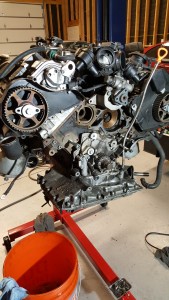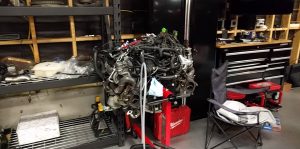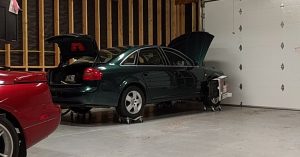Day 4 was the flip side of day 2: I took off the driver’s side valve cover, removed the seals and prepared it for new gaskets.
Not terribly exciting, but another hour of work down.
Today was all about the front crankshaft seal. It wasn’t leaking, but it was accessible with the engine out, so why not? Well… one could argue: don’t fix it if it ain’t broke, that’s why not.
First step was to get the crankshaft harmonic balancer bolt out. This bolt is torqued to 150 lb/ft… and then turned another 180 degrees. It’s in there tight… so tight that the force actually stretches the bolt. Getting the bolt out took me about ten minutes of straining, spraying penetrating oil and an air impact gun.

Since it wasn’t leaking it was a bit of a pain to pull out. By the time I realized I should have left well enough alone, I had already beat up the front of the seal, so it had to come out. With John’s help the seal finally came loose. Putting the new seal in was simply a matter of finding the right tool to seat the seal (which, when you don’t have a seal tool, the right tool is a 36mm Craftsman socket).
On the second day I pulled the passenger side valve cover and scraped the surfaces to prepare them for new seals. Before I can complete the valve covers I’m going to replace the camshaft seals, so I won’t be buttoning it down quite yet (but am keeping it covered to keep debris out).
Spent about an hour carefully cleaning up the gasket surfaces.
After the slow pace we were forced to take with the engine extraction, working on the engine is going much more quickly (having it on a stand helps tremendously).
I started the day’s work by pulling the shrouds of the front of the timing belt circuit. About an hour of pushing, pulling, tugging and grunting I had the front end mostly disassembled.

In addition to replacing the timing belt, there are several seals that might as well be replaced too. Before we pulled the engine we found oil in cylinder one (as well as high compression). With the hope that it’s a leak in the valve cover gaskets, I’ll be replacing those. I’ll also check the main crank seal and camshaft seals. The engine is out of the car, so it’s the easiest time to get to the parts.
Day one I removed the timing belt, water pump, thermostat, and thermostat housing. After cleaning grease and oil off the engine front, I installed a new water pump, thermostat and thermostat housing. The first block of work was about 4 hours.
At the time we pulled the engine out of the A6 I wasn’t yet taking careful notes on the project. I’m guessing we spent 36-48 hours total on pulling the engine.
Getting the engine out was a struggle as we worked to access bolts that were buried deep in the engine bay. In retrospect we should have dropped the entire front end, it would have saved us a lot of headaches. We’re certain to do that for pulling the engine out of the A4.
John and I worked for hours trying to get the engine out. When I dropped out for a bit with a sinus infection, John took the job the last few miles and got the engine out of the A6 and onto an engine stand. I’m lucky to have a great friend like John.

The A6, now thoroughly emasculated, looks dejected in the corner of the garage.

Progress continues, now with a case!
More info: http://straightapex.com/beta-unit-two-hits-the-road/
First iteration is working! More info at Straight Apex: http://straightapex.com/first-alpha-unit/
Gran Tourismo, Playstation’s ultimate driving simulation game (some argue it’s the best on any platform), has announced a feature that bridges the gap between video games and track days.
Back in the good old days, when Mike and I used to have “racing budget”, we practiced driving Laguna Seca on the PS2 with Gran Tourismo, then went and drove the track for real. If we did it now, however, we could take it one step farther by bringing the results of our track day back home and reviewing them on the new version of Gran Tourismo.
Here’s how it works: while at your track day you record your lap times and lines using GPS and “CAN”. When you return home you put the data on a USB stick and plug it into your PS3. You can replay the data by watching your run around the track or use the data as a ghost and race against yourself to improve your lines or see how you would fare against, say, an F1 car (spoiler alert: not very well).
What type of data logger hardware you need isn’t terribly clear in the press release, it just says you need log CAN data. As for tracks, I think it’s a safe assumption that the feature will be limited to the tracks already part of the software.
I really liked the last Cadillac CTS-V and probably would have bought one if the interior didn’t feel so cheep. I also like the tweaks they’ve made to the styling of the new CTS. I’m not sure, however, that I like the new CTS-V.

Sure, it’s got all kinds of sexy under the hood and the interior looks much improved… but the outside looks like they made it a bit too bumpy/bulgy. I’m sure they wanted to make it seem extra-tough… but it’s looking like they may have gone past the look of a sleek athlete and ended up with something a little more cartoon superhero.
I’ll reserve final judgement until I see it in person, but with 550HP & lbs/ft I suspect I’d never want to be looking at it from the outside.
via: autoblog